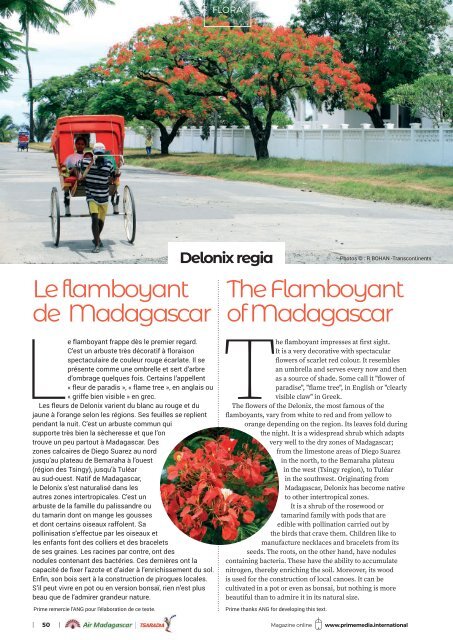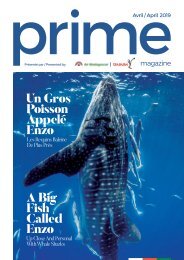PRIME MAG - AIR MAD - SEPTEMBER 2018 - SINGLE PAGES - ALL PAGES
- No tags were found...
Create successful ePaper yourself
Turn your PDF publications into a flip-book with our unique Google optimized e-Paper software.
FLORA<br />
FLORA<br />
Le flamboyant<br />
de Madagascar<br />
Delonix regia<br />
Photos © : R.BOHAN -Transcontinents<br />
The Flamboyant<br />
of Madagascar<br />
Le flamboyant frappe dès le premier regard.<br />
C’est un arbuste très décoratif à floraison<br />
spectaculaire de couleur rouge écarlate. Il se<br />
présente comme une ombrelle et sert d’arbre<br />
d’ombrage quelques fois. Certains l’appellent<br />
« fleur de paradis », « flame tree », en anglais ou<br />
« griffe bien visible » en grec.<br />
Les fleurs de Delonix varient du blanc au rouge et du<br />
jaune à l’orange selon les régions. Ses feuilles se replient<br />
pendant la nuit. C’est un arbuste commun qui<br />
supporte très bien la sècheresse et que l’on<br />
trouve un peu partout à Madagascar. Des<br />
zones calcaires de Diego Suarez au nord<br />
jusqu’au plateau de Bemaraha à l’ouest<br />
(région des Tsingy), jusqu’à Tuléar<br />
au sud-ouest. Natif de Madagascar,<br />
le Delonix s’est naturalisé dans les<br />
autres zones intertropicales. C’est un<br />
arbuste de la famille du palissandre ou<br />
du tamarin dont on mange les gousses<br />
et dont certains oiseaux raffolent. Sa<br />
pollinisation s’effectue par les oiseaux et<br />
les enfants font des colliers et des bracelets<br />
de ses graines. Les racines par contre, ont des<br />
nodules contenant des bactéries. Ces dernières ont la<br />
capacité de fixer l’azote et d’aider à l’enrichissement du sol.<br />
Enfin, son bois sert à la construction de pirogues locales.<br />
S’il peut vivre en pot ou en version bonsaï, rien n’est plus<br />
beau que de l’admirer grandeur nature.<br />
Prime remercie l'ANG pour l'élaboration de ce texte.<br />
The flamboyant impresses at first sight.<br />
It is a very decorative with spectacular<br />
flowers of scarlet red colour. It resembles<br />
an umbrella and serves every now and then<br />
as a source of shade. Some call it "flower of<br />
paradise", "flame tree", in English or "clearly<br />
visible claw" in Greek.<br />
The flowers of the Delonix, the most famous of the<br />
flamboyants, vary from white to red and from yellow to<br />
orange depending on the region. Its leaves fold during<br />
the night. It is a widespread shrub which adapts<br />
very well to the dry zones of Madagascar;<br />
from the limestone areas of Diego Suarez<br />
in the north, to the Bemaraha plateau<br />
in the west (Tsingy region), to Tuléar<br />
in the southwest. Originating from<br />
Madagascar, Delonix has become native<br />
to other intertropical zones.<br />
It is a shrub of the rosewood or<br />
tamarind family with pods that are<br />
edible with pollination carried out by<br />
the birds that crave them. Children like to<br />
manufacture necklaces and bracelets from its<br />
seeds. The roots, on the other hand, have nodules<br />
containing bacteria. These have the ability to accumulate<br />
nitrogen, thereby enriching the soil. Moreover, its wood<br />
is used for the construction of local canoes. It can be<br />
cultivated in a pot or even as bonsai, but nothing is more<br />
beautiful than to admire it in its natural size.<br />
Prime thanks ANG for developing this text.<br />
| 50 | Magazine online www.primemedia.international















